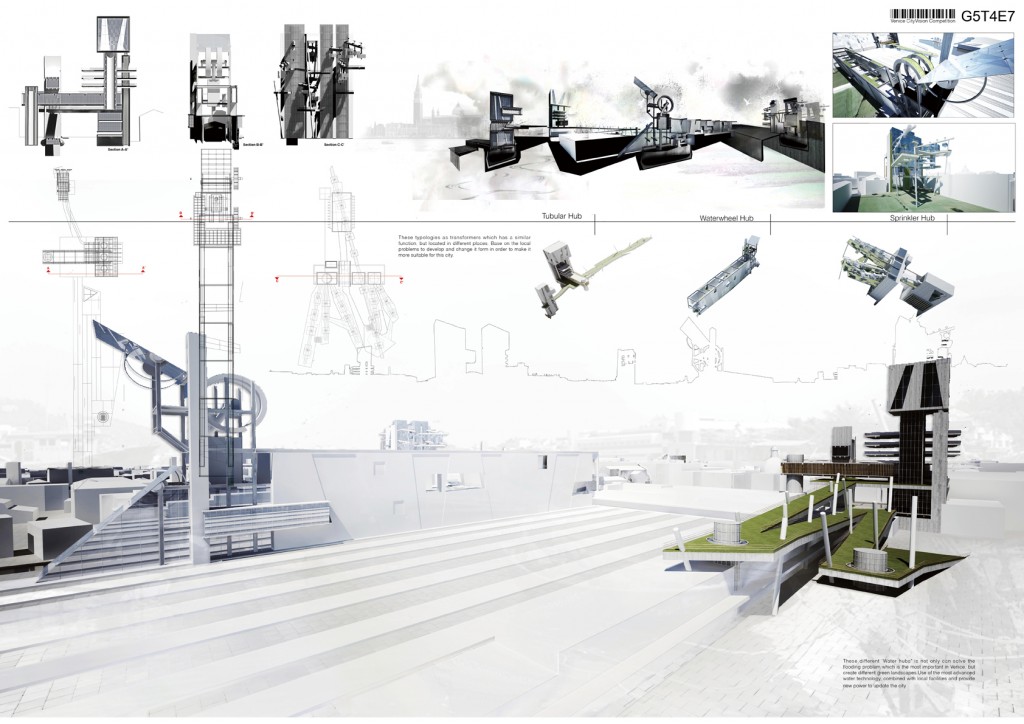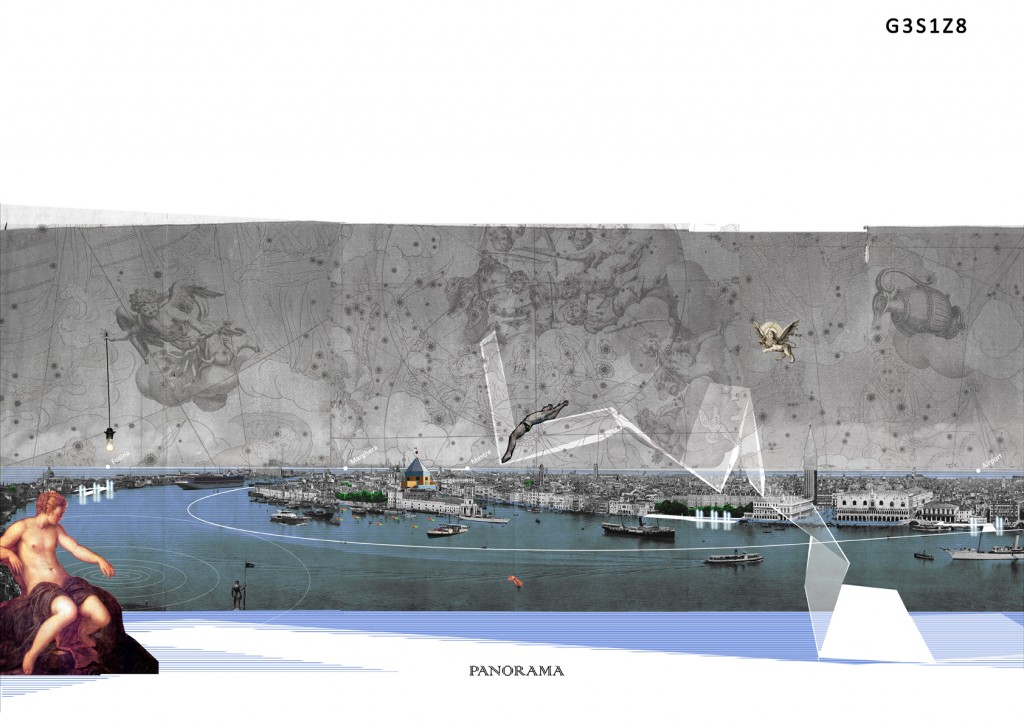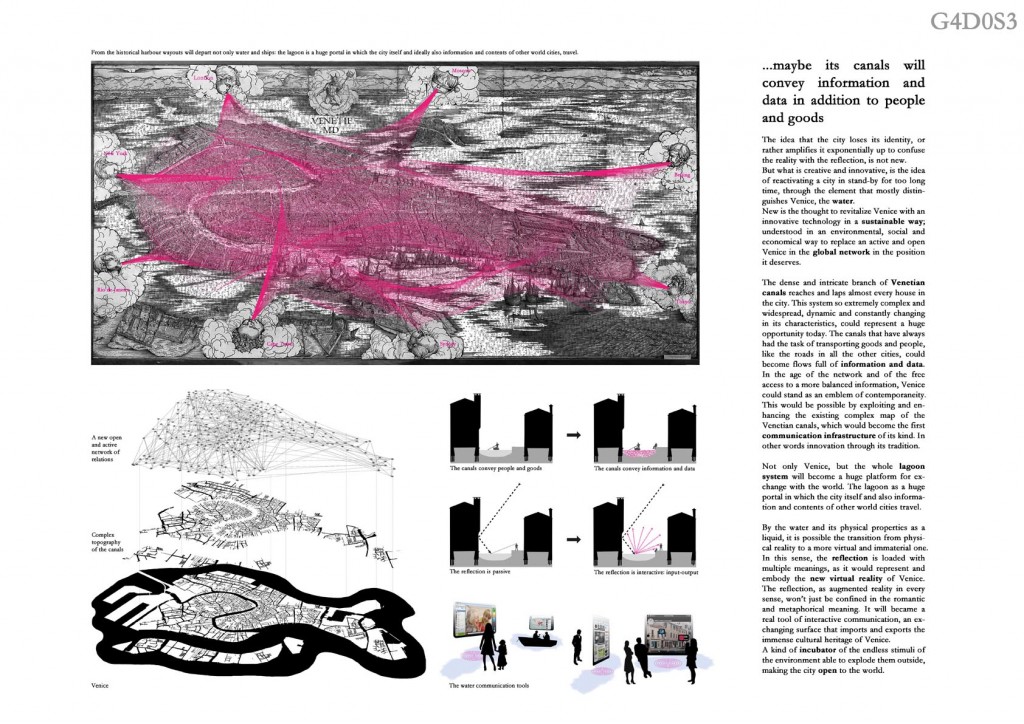Info:
Title: …if Venice survives through reflection? - Code: G4D0S3Contest: Venice / 2011
By: A. Carabini / A. Braggion
Views: 3293 Likes: 6
Votes:
BJARKE INGELS10 NERI OXMAN4 ELENA MANFERDINI4 MARIA LUDOVICA TRAMONTIN8 BOSTJAN VUGA46.0
…if Venice survives through reflection?
…if Venice survives through reflection? “And if we are indeed partly synonymous with water, which is fully synonymous with time, then one’s sentiment toward this place improves the future, contributes to that Adriatic or Atlantic of time which stores our reflections for when we are long gone. Out of them, as out of frayed sepia pictures, time will perhaps be able to fashion, in a collage-like-manner, a version of the future better than it would be without them. This way one is Venetian by definition, because out there, in its equivalent of the Adriatic or Atlantic or Baltic, time –alias – water crochets or weaves our reflections – alias love for this place – into unrepeatable patterns…”
Joseph Brodsky, Watermark
Anyone who has lived, or has simply stopped in this city for a few days, knows that there are two Venice off the coast of the Adriatic sea, two identical city living under the same sky. In the eyes of the careless tourist maybe these two cities seem to be the same thing, or one is trivially a continuum of the other, but in reality these two cities have very little in common beyond the fact of resting their feet on the surface of the same sea. And perhaps the most important thing that joins them, besides the name of course, is the ability to generate wonder and astonishment in all the people’s eyes, just like in a never-ending race in which neither will ever be able to overcome the other. Or at least, until now has been so.
Leaving aside the beauty which sets them apart, what differentiates them and makes them unique essentially is the material of which they are made. One is built of stone and brick, is firm, penetrable and screams his strength and solidity. You can touch her, you can enjoy her for hours, you can live her, and she will never refuse you a photograph. But unfortunately, she is not immortal, and looks like a huge clock of the world through which you can realize the passage of time, and year by year, century by century, shows its wrinkles and all its fragility and weakness.
The other Venice instead, the upside down one, citing Calvin, is untouchable, unfathomable, impenetrable, unreachable. The infinite in which she throws you is the inevitable consequence of the mystery that surrounds her. You cannot touch her otherwise she would disappear, you may want to lock her in a photograph, but it would be useless because in the meantime she has changed and rechanged thousands of times, even millions. And for this reason, many people have approached her to the concept and idea of the soul.
But what if this Venice, made of water, is the answer and the instrument for a contemporary long-awaited renaissance?
And if this Venice, always considered as a consequence of the other, is charged with life and meaning to the point of no longer distinguish reality from his own reflection? And if that happens, and its canals convey information and data in addition to people?
Maybe the Venice where we will choose to live in the future is alive in the reflection of the city that today we’re leaving. Maybe Venice will return to be a city and will find its contemporaneity, becoming the symbol and the emblem of a renewed life.
The idea that the city loses its identity, or rather amplifies it exponentially up to confuse the reality with the reflection, is not new. In the sense, have a look at some views of Lifschitz or Monet if you want to go further back in time. But what is creative and innovative, is the idea of reactivating a city in stand-by for too long time, through the element that mostly distinguishes Venice all over the world and has determined its fortune and greatness, but also pain and degradation, the water. New is the thought to revitalize Venice in a sustainable way, understood in an environmental way preserving the natural and cultural heritage of the city and of the lagoon system. In an economical way through the use of instruments and modern technologies that are flexible, removable, proportionate and harmonized with the city. And finally in a social one, as a platform able to attract, generate cohesion and interaction, import and export ideas and creativity, and especially replace an active and open Venice in the global network in the position it deserves.
The dense and intricate branch of Venetian canals reaches and laps almost every house in the city. This system so extremely complex and widespread, dynamic and constantly changing in its characteristics, could represent a huge opportunity today. The canals that have always had the task of transporting goods and people, like the roads in all the other cities, could become flows full of information and data. In the age of the network and of the free access to a more balanced information, Venice could stand as an emblem of contemporaneity. This would be possible by exploiting and enhancing the existing complex map of the Venetian canals, which would become the first communication infrastructure of its kind. In other words, innovating and re-activating the city starting from its real essence: innovation through its tradition.
By the water and its physical properties as a liquid, it is possible the transition from physical reality to a more virtual and immaterial one. Its clear advantages and opportunities will allow the regeneration of the physical Venice. So the virtual world as a key to bring new energy to the physical city, in social, cultural and economical terms.
In this sense, the reflection is loaded with multiple meanings, as it would represent and embody the new virtual reality of Venice. The reflection, as augmented reality in every sense, won’t just be confined in the romantic and metaphorical meaning. It will became a real tool of interactive communication, an exchanging surface that imports and exports the immense cultural heritage of Venice. A kind of incubator of the endless stimuli of the environment able to explode them outside, making the city open to the world.
Venice is magical just because it has this added value, it already has a kind of augmented reality which is given by its reflection, by being constantly in between two worlds, two parallel cities always present. So the question naturally arises: which place in the world is more suitable to imagine the coexistence of a people real life and their augmented reality? And in both cases, physical and social structure of the city, it is the water that allows this “augment”.
And if now the open and incredibly artificial system of the lagoon of Venice is limited to being the place of the exchange between land and sea, in the future it could increase its role. So not only Venice, but the whole lagoon system will become a huge platform for exchange with the world. The lagoon as a huge portal in which the city itself and also information and contents of other world cities travel. From the historical harbour wayouts will depart not only water and ships, but ideally also information and data. Venice will return lively as in the past, becoming that interactive and multimedia hub that we all dream.
Related Posts :
Comments:
Info:
Title: …if Venice survives through reflection?
Time: 7 giugno 2011
Category: Venice
Views: 3293 Likes: 6
Tags: Adriatic , Adriatic Sea , American Geophysical Union , Joseph Brodsky , Piazza San Marco , Scripps Institution of Oceanography , Venetian Lagoon , Venice








